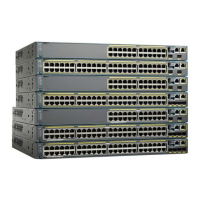Users who fail authentication remain in the restricted VLAN until the next re-authentication attempt. A port
in the restricted VLAN tries to re-authenticate at configured intervals (the default is 60 seconds). If
re-authentication fails, the port remains in the restricted VLAN. If re-authentication is successful, the port
moves either to the configured VLAN or to a VLAN sent by the RADIUS server. You can disable
re-authentication. If you do this, the only way to restart the authentication process is for the port to receive a
link down or EAP logoff event. We recommend that you keep re-authentication enabled if a client might
connect through a hub. When a client disconnects from the hub, the port might not receive the link down or
EAP logoff event.
After a port moves to the restricted VLAN, a simulated EAP success message is sent to the client. This prevents
clients from indefinitely attempting authentication. Some clients (for example, devices running Windows XP)
cannot implement DHCP without EAP success.
Restricted VLANs are supported on 802.1x ports in all host modes and on Layer 2 ports.
You can configure any active VLAN except an RSPAN VLAN, a primary private VLAN, or a voice VLAN
as an 802.1x restricted VLAN. The restricted VLAN feature is not supported on internal VLANs (routed
ports) or trunk ports; it is supported only on access ports.
Other security port features such as dynamic ARP Inspection, DHCP snooping, and IP source guard can be
configured independently on a restricted VLAN.
802.1x Authentication with Inaccessible Authentication Bypass
Use the inaccessible authentication bypass feature, also referred to as critical authentication or the AAA fail
policy, when the switch cannot reach the configured RADIUS servers and new hosts cannot be authenticated.
You can configure the switch to connect those hosts to critical ports.
When a new host tries to connect to the critical port, that host is moved to a user-specified access VLAN, the
critical VLAN. The administrator gives limited authentication to the hosts.
When the switch tries to authenticate a host connected to a critical port, the switch checks the status of the
configured RADIUS server. If a server is available, the switch can authenticate the host. However, if all the
RADIUS servers are unavailable, the switch grants network access to the host and puts the port in the
critical-authentication state, which is a special case of the authentication state.
If critical authentication is configured on interface, then vlan used for critical authorization (critical vlan)
should be active on the switch. If the critical vlan is inactive (or) down, critical authentication session
will keep trying to enable inactive vlan and fail repeatedly. This can lead to large amount of memory
holding.
Note
Inaccessible Authentication Bypass Support on Multiple-Authentication Ports
When a port is configured on any host mode and the AAA server is unavailable, the port is then configured
to multi-host mode and moved to the critical VLAN. To support this inaccessible bypass on
multiple-authentication (multiauth) ports, use the authentication event server dead action reinitialize vlan
vlan-id command. When a new host tries to connect to the critical port, that port is reinitialized and all the
connected hosts are moved to the user-specified access VLAN.
This command is supported on all host modes.
Catalyst 2960-X Switch Security Configuration Guide, Cisco IOS Release 15.0(2)EX
OL-29048-01 285
Configuring IEEE 802.1x Port-Based Authentication
802.1x Authentication with Inaccessible Authentication Bypass
